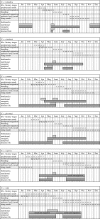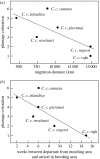Travelling on a budget: predictions and ecological evidence for bottlenecks in the annual cycle of long-distance migrants
- PMID: 17638692
- PMCID: PMC2606749
- DOI: 10.1098/rstb.2007.2138
Travelling on a budget: predictions and ecological evidence for bottlenecks in the annual cycle of long-distance migrants
Abstract
Long-distance migration, and the study of the migrants who undertake these journeys, has fascinated generations of biologists. However, many aspects of the annual cycles of these migrants remain a mystery as do many of the driving forces behind the evolution and maintenance of the migrations themselves. In this article we discuss nutritional, energetic, temporal and disease-risk bottlenecks in the annual cycle of long-distance migrants, taking a sandpiper, the red knot Calidris canutus, as a focal species. Red knots have six recognized subspecies each with different migratory routes, well-known patterns of connectivity and contrasting annual cycles. The diversity of red knot annual cycles allows us to discuss the existence and the effects of bottlenecks in a comparative framework. We examine the evidence for bottlenecks focusing on the quality of breeding plumage and the timing of moult as indicators in the six subspecies. In terms of breeding plumage coloration, quality and timing of prealternate body moult (from non-breeding into breeding plumage), the longest migrating knot subspecies, Calidris canutus rogersi and Calidris canutus rufa, show the greatest impact of bottlenecking. The same is true in terms of prebasic body moult (from breeding into non-breeding plumage) which in case of both C. c. rogersi and C. c. rufa overlaps with southward migration and may even commence in the breeding grounds. To close our discussion of bottlenecks in long-distance migrants, we make predictions about how migrants might be impacted via physiological 'trade-offs' throughout the annual cycle, using investment in immune function as an example. We also predict how bottlenecks may affect the distribution of mortality throughout the annual cycle. We hope that this framework will be applicable to other species and types of migrants, thus expanding the comparative database for the future evaluation of seasonal selection pressures and the evolution of annual cycles in long-distance migrants. Furthermore, we hope that this synthesis of recent advancements in the knowledge of red knot annual cycles will prove useful in the ongoing attempts to model annual cycles in migratory birds.
Figures



Similar articles
-
The effects of long-distance migration on the evolution of moult strategies in Western-Palearctic passerines.Biol Rev Camb Philos Soc. 2019 Apr;94(2):700-720. doi: 10.1111/brv.12474. Epub 2018 Oct 18. Biol Rev Camb Philos Soc. 2019. PMID: 30334341 Review.
-
Seasonal Time Keeping in a Long-Distance Migrating Shorebird.J Biol Rhythms. 2016 Oct;31(5):509-21. doi: 10.1177/0748730416655929. Epub 2016 Jul 27. J Biol Rhythms. 2016. PMID: 27466352
-
Many routes lead to Rome: potential causes for the multi-route migration system of Red Knots, Calidris canutus Islandica.Ecology. 2010 Jun;91(6):1822-31. doi: 10.1890/09-1281.1. Ecology. 2010. PMID: 20583722
-
Optimal moult strategies in migratory birds.Philos Trans R Soc Lond B Biol Sci. 2008 Jan 27;363(1490):211-29. doi: 10.1098/rstb.2007.2136. Philos Trans R Soc Lond B Biol Sci. 2008. PMID: 17681914 Free PMC article.
-
A long winter for the Red Queen: rethinking the evolution of seasonal migration.Biol Rev Camb Philos Soc. 2019 Jun;94(3):737-752. doi: 10.1111/brv.12476. Epub 2018 Nov 4. Biol Rev Camb Philos Soc. 2019. PMID: 30393938 Review.
Cited by
-
A hidden cost of migration? Innate immune function versus antioxidant defense.Ecol Evol. 2018 Feb 7;8(5):2721-2728. doi: 10.1002/ece3.3756. eCollection 2018 Mar. Ecol Evol. 2018. PMID: 29531689 Free PMC article.
-
Juvenile salmon usage of the Skeena River estuary.PLoS One. 2015 Mar 6;10(3):e0118988. doi: 10.1371/journal.pone.0118988. eCollection 2015. PLoS One. 2015. PMID: 25749488 Free PMC article.
-
Characterization of MHC class I in a long-distance migrant shorebird suggests multiple transcribed genes and intergenic recombination.Immunogenetics. 2013 Mar;65(3):211-25. doi: 10.1007/s00251-012-0669-2. Epub 2012 Dec 14. Immunogenetics. 2013. PMID: 23239370
-
Morphometrics and stable isotopes differentiate wintering populations of a migratory bird.Mov Ecol. 2016 Aug 2;4:20. doi: 10.1186/s40462-016-0085-6. eCollection 2016. Mov Ecol. 2016. PMID: 27486515 Free PMC article.
-
Migratory connectivity and population-specific migration routes in a long-distance migratory bird.Proc Biol Sci. 2014 Jan 15;281(1778):20132897. doi: 10.1098/rspb.2013.2897. Print 2014 Mar 7. Proc Biol Sci. 2014. PMID: 24430850 Free PMC article.
References
-
- Alerstam T. Cambridge University Press; Cambridge, UK: 1990. Bird migration.
-
- Alerstam T, Hedenström A, Åkesson S. Long-distance migration: evolution and determinants. Oikos. 2003;103:247–260. doi:10.1034/j.1600-0706.2003.12559.x - DOI
-
- Anderson R.M, May R.M. Oxford University Press; New York, NY: 1992. Infectious diseases of humans: dynamics and control.
-
- Arneberg P. Host population density and body mass as determinants of species richness in parasite communities: comparative analysis of directly transmitted nematodes of mammals. Ecography. 2002;25:88–94. doi:10.1034/j.1600-0587.2002.250110.x - DOI
-
- Atkinson P.W, Baker A.J, Bevan R.M, Clark N.A, Cole K.B, Gonzalez P.M, Newton J, Niles L.J, Robinson R.A. Unravelling the migration and moult strategies of a long-distance migrant using stable isotopes: red knot Calidris canutus movements in the Americas. Ibis. 2005;147:738–749. doi:10.1111/j.1474-919x.2005.00455.x - DOI
Publication types
MeSH terms
LinkOut - more resources
Full Text Sources

